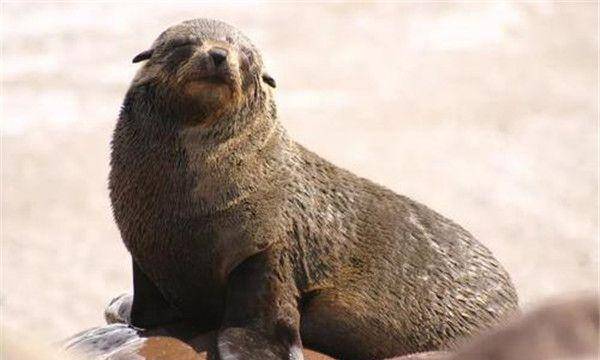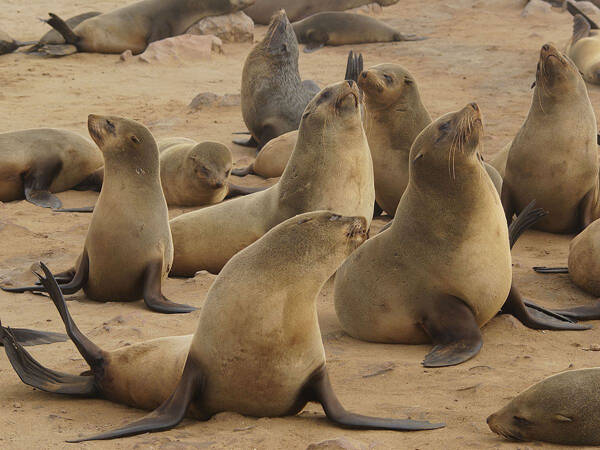Arctocephalus pusillus
IUCN
LCBasic Information
Scientific classification
- name:Arctocephalus pusillus
- Scientific Name:Arctocephalus pusillus,South African and Australian Fur Seal,Cape fur seal, African fur sea lion, South African fur sea lion, Australian fur sea lion
- Outline:Carnivora
- Family:S.L.family
Vital signs
- length:1.8-2.3m
- Weight:150-360kg
- lifetime:About 20 years
Feature
The largest fur seal
Distribution and Habitat
The African-Australian fur sea lion is distributed in southern Africa and southern Australia. It is divided into two subspecies: the southern African subspecies (A. Ppusillus) breeds along the temperate coast between southwest and southern Africa and the Algoa Gulf; the Australian subspecies (A. Pdoriferus Wood Jones, 1925) breeds along the southeastern coast of Australia.
Appearance
The African fur sea lion is the largest fur sea lion. The male is about 230 cm long and weighs more than 360 kg. The female is obviously smaller than the male, with a body length of 180 cm and a weight of 150 kg.
Its body is slender and spindle-shaped, with a skull length of about 304 mm, a nasal bone length of about 55 mm, a long snout, and well-developed occipital and sagittal ridges. The eyes are large, and the forehead between the eye sockets is convex. There is a pair of small conical pointed ear shells on the head. The mouth is large, and there are many whisker-like tactile hairs around it. The teeth are not highly differentiated, the canines are large and well-developed, much like carnivores on land, but the teeth behind the canines are simple in structure, almost the same as the isomorphic teeth, and there are no carnassial teeth like carnivores. The upper left and right teeth are arranged in parallel. The posterior cheek teeth are thick, with obvious anterior and posterior
Details
The scientific name of the African fur seal is Arctocephalus pusillus, and its foreign name is South African and Australian Fur Seal. There are two subspecies.

African fur sea lions are gentle and like to gather in groups. They generally do not have a fixed habitat except during the breeding season. Males spend 2 to 3 weeks each month patrolling far away for food, while females and cubs spend relatively more time on land. They hunt in the sea during the day, rely on their long forelimbs for swimming and diving, and occasionally crawl onto the shore to bask in the sun, and sleep on the shore at night.
The main food of African fur sea lions includes mollusks, crustaceans and fish, which are mostly swallowed whole without chewing. They are very alert when they are on the shore, and they quickly return to the sea water at the slightest sign of trouble. Even when they are sleeping, there are "sentinels" in the group who serve as guards. When they find danger, they immediately send signals to inform their companions. Its vision is poor, but its hearing and sense of smell are very sensitive, especially the base of its whiskers is crisscrossed with nerves, which not only has a strong sense of touch, but also is a sound receptor with high precision, which can emit a series of sound signals to the surroundings, and then collect the echoes returned from the target to determine the size and shape of the target, so as to accurately identify the object.
African fur sea lions are polygamous animals. During the breeding season from November to December every year, the strong males will first arrive at the breeding grounds on the shore and divide their territory on the beach or reefs. After that, groups of females will come in large numbers, making the coast a very lively scene. The males first stand on the beach and warmly welcome the arrival of the females, and then fight desperately for mates. The more powerful and capable they are, the more females they can grab. Finally, many "independent kingdoms" composed of one male and multiple females are formed, which are called reproductive groups or polygamous groups. However, after the reproductive group is formed, the females do not mate with the males immediately, because they have been pregnant for a long time and are about to give birth, so they must first prepare for "giving birth to children". They will start mating with males one week after giving birth to the cubs. After conception, they will give birth again when the breeding season arrives the following year.

Females need to mate 1 to 3 times during a breeding season. Generally, the earlier the mating after giving birth, the higher the fertilization rate. After each female becomes pregnant, it immediately withdraws from the multi-female group and is gradually replaced by other unmated females. During the 5-6 week breeding period, the male does not go to the sea, does not eat or drink, and mates up to 30 times a day, each mating lasting about 15 minutes. The male relies on the fat accumulated in the body to maintain this huge consumption until the end of the breeding period. The female only gives birth to one cub per litter, and it only takes about 10 minutes to give birth to the cub, which is not difficult. The newborn cub is about 75 cm long and weighs about 7 kg. The body surface is covered with thick, soft and curly black short hair. After the first molting, it is replaced by black hair with white tips and thick brown hair, which falls off after one year. The cub can move as soon as it opens its eyes, but it needs the patient care of the female. When the female moves, she always carries it in her mouth. The female's milk is very thick and has a high fat content, so breastfeeding once every 1-2 days or more can give the cub enough nutrition and grow quickly.
A week after giving birth, the female will go into the water to look for food for one or two days. After that, the time spent looking for food will gradually increase, and sometimes it will take more than a week to come back. In order to quickly find her cubs in the densely packed group, the female will call loudly after landing. Her cubs will immediately respond after hearing it, and move eagerly in the direction of the female's call, and soon get close together. In addition to calling with calls, they also use their sense of smell to find each other by smelling each other's scent. Newborn cubs cannot swim and dare not go into the water. They start to supplement their food with small crustaceans and small fish in May and June. After that, they slowly learn to swim and hunt in the sea. They reach sexual maturity at the age of 3 to 5 and can live for more than 20 years.
At 1:43 pm on May 21, 2004, a burst of "crying" was heard from the "home" of the sea lions in the marine animal hall of Dalian Laohutan Polar Museum. The fur sea lion Zoria gave birth to a lovely sea lion "little princess". Relevant experts said that this is the first fur sea lion born by artificially bred sea lions in the country, which has extremely high scientific research and ornamental value.
In the Convention on International Trade in Endangered Species of Wild Fauna and Flora, African fur sea lions are listed in Appendix II.
Protect wild animals and eliminate game.
Maintaining ecological balance is everyone's responsibility!








